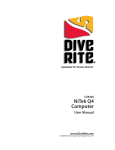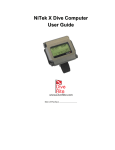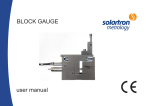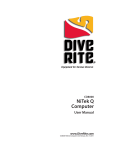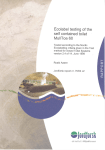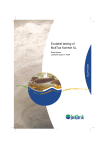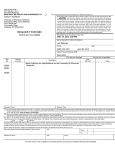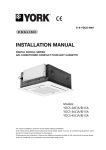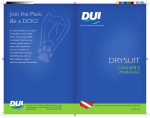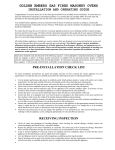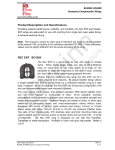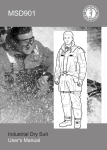Download Using and diving the 905 EXP Drysuit
Transcript
905 Drysuit System User Guide Date of purchase: www.diverite.com Content DEVELOPED BY Dive Rite 175 NW Washington Street Lake City, FL 32055 Phone: 386.752.1087 Fax: 386.755.0613 Web: www.DiveRite.com COPYRIGHT NOTICE Copyright © 2008 Lamartek, Inc. dba Dive Rite WARRANTY INFORMATION Dive Rite will—at its sole discretion—repair or replace 905 EXP Drysuit components proved to be damaged by faulty manufacture or material, at no cost, for a period of up to three years from the date of purchase, including seams. Zipper, valves, and boots are covered under a oneyear warranty. This manual is copyrighted by Lamartek, Inc. dba Dive Rite. You may not reproduce, translate, transcribe, or transmit any part of this manual without express, written permission from Lamartek, Inc. dba Dive Rite. This warranty applies only to the original retail purchaser. It does not cover commercial or rental use, nor does it extend to units purchased from other than an authorized Dive Rite dealer. This warranty specifically excludes damage to wrist and neck seals, boot punctures, zipper damage or failure, damage to the low-pressure inflator hose or damage due to improper “pee” valve installation. Damage to these items can be avoided through proper use and care. Seam repairs should not be attempted utilizing "Aquaseal" or similar materials. These materials render the suit impossible to repair using factory methods; use of these materials void the manufacturer's warranty. All seam repairs must be done at the factory to receive warranty coverage. This warranty further excludes color changes, light fastness, or fading. Dive Rite does not accept responsibility for stains or transference or bleeding of color to other items. To make a claim under this warranty, the owner must have registered his/her warranty using Dive Rite’s website (www.diverite.com). All warranty repairs (international or domestic) must be accompanied by a copy of the purchase receipt. For warranty repairs (international or domestic) the product must be returned to the store where the item was purchased or directly to Dive Rite. A Return Authorization must be obtained by calling Dive Rite corporate offices (386-752-1087) to send items to Dive Rite. No warranty service will be performed for other than registered owners. Note: Local dealers and distributors are not responsible for service of items purchased from unauthorized dealers, internet dealers, or dealers from other territories. This warranty becomes void if 905 EXP Drysuit components are damaged by anything other than normal recreational diving use, or if they have been serviced or repaired by other than authorized Dive Rite dealers. Repairs made under this warranty will not extend the warranty period. All further claims, especially for damage after diving accidents, are excluded from coverage under this warranty. Dive Rite has no obligation to honor any extension of this warranty. This warranty is in lieu of all other warranties, expressed or implied. No other person or representative is authorized to assume for Dive Rite any other liability in connection with the sale of this product. 905 EXP Drysuit User Manual i Content ii 905 EXP Drysuit User Manual Content Table of contents Chapter 1 Introduction • 1 Overview • 2 Features and functions • 3 Specifications • 6 Warnings • 7 Drysuit guidelines and safety precautions • 8 905 EXP Drysuit label • 10 905 EXP Drysuit accessories • 11 Chapter 2 Preparing the 905 EXP Drysuit for use • 15 Getting started • 16 Attaching the inflator hose to your regulator • 17 Sizing and trimming the neck and wrist seals • 18 Chapter 3 Using and diving the 905 EXP Drysuit • 21 Performing a pre-dive inspection • 22 Putting on the drysuit • 23 Diving the 905 EXP Drysuit • 26 Taking off the drysuit • 32 Chapter 4 Care and maintenance • 33 Care and maintenance • 34 Storing your drysuit • 35 Repairing the 905 EXP Drysuit • 37 Chapter 5 Emergency procedures • 38 Possible emergencies • 39 Index • 42 905 EXP Drysuit User Manual iii Content iv 905 EXP Drysuit User Manual Chapter 1 Introduction Summary This chapter provides an overview of the 905 EXP Drysuit, lists the 905 EXP Drysuit’s features and functions, and covers warning information that should be read before using your 905 EXP Drysuit. Content Overview • 2 Features and functions • 3 Specifications • 6 Warnings • 7 Drysuit guidelines and safety precautions • 8 905 EXP Drysuit label • 9 905 EXP Drysuit accessories • 10 905 EXP Drysuit User Manual 1 Introduction Overview Congratulations on your purchase of the 905 EXP Drysuit. The 905 EXP Drysuit is an exposure protection diving system designed to keep you warm and dry while diving. The 905 EXP Drysuit is a shell type drysuit that by itself provides minimal thermal protection. The 905 EXP Drysuit is designed for use with a thermal undergarment, such as Dive Rite’s Polartec or Primaloft. The 905 EXP Drysuit’s design allows for a dry layer of air between the drysuit shell and your body. With the use of different undergarments, the 905 EXP Drysuit is a versatile exposure protection system that can be used in a variety of diving applications. The 905 EXP Drysuit comes standard with a drysuit inflator hose, carrying bag, and a service/repair kit. Caution: It is extremely important that you carefully read and understand this manual. Make sure you fully understand how the 905 EXP Drysuit operates before diving with it. This manual has been divided into the following chapters: • Introduction: Covers the features and functions, specifications, and warnings for the 905 EXP Drysuit • Preparing the 905 EXP Drysuit for use: Covers wrist and neck seal sizing and trimming and inflator hose connection • Using and diving the 905 EXP Drysuit: This chapter covers the proper procedures for putting on and taking off the drysuit, performing a pre-dive inspection, buoyancy control while diving, ascending and descending in the suit, and diving with different sizes of tanks • Care and maintenance: Covers how to properly care for and maintain the 905 EXP Drysuit • Emergency procedures: Covers how to deal with emergency situations 2 905 EXP Drysuit User Manual Introduction Features and functions The 905 EXP Drysuit is made of butyl rubber, encapsulated between layers of polyester fabric. The seams are ultrasonically welded, making them extremely strong and durable. The drysuit also features reinforced wear areas on the knees, elbows, shoulders, and crotch, a protective zipper flap, and an inside label that contains the suit’s serial number and other important information. The following diagram and table details the different features of the 905 EXP Drysuit. Neck seal Warm neck collar Shoulder pad Exhaust valve Swivel inlet valve Wrist seals Thigh pocket Thigh pocket Boots Feature Description Neck seal The latex neck seal provides a watertight seal around the neck. Sizing adjustments must be made to get a proper fit and seal 905 EXP Drysuit User Manual 3 Introduction Feature Description around your neck. Warm neck collar The warm neck collar is used with a warm neck hood. The bib on the hood must be tucked inside the warm neck collar, which helps to keep water from circulating around your neck, keeping your neck area warmer. Swivel inlet valve The inlet valve allows you to put air inside the drysuit to reduce suit squeeze and adjust buoyancy. The drysuit inflator hose connects to this valve. The valve swivels allowing the inflator hose to be routed in any position desired. Wrist seals The latex wrist seals provide a watertight seal around the wrists. Sizing adjustments must be made to get a proper fit and seal around your wrists. Thigh pockets The thigh pockets are used for the storage of slates, clips, knife, etc. Both pockets are fixed. Boots The boots are insulated and watertight and provide protection and traction Shoulder pads The shoulder pads protect the drysuit from the straps of your BC or harness system from digging into the suits material Exhaust valve The exhaust valve is used to vent air from the drysuit by pressing down on the valve. The valve can be adjusted to vent air easier or to keep air from venting. Waterproof zipper (not visible) The waterproof zipper provides a watertight seal and allows you to put on and take off the drysuit Suspenders (not visible) Suspenders keep the waist portion of the drysuit from sagging, creating a bunching of material around your legs. The suspenders also allow you to wear the drysuit with the top half hanging down around your waist before, between, and after dives. 4 905 EXP Drysuit User Manual Introduction The 905 EXP Drysuit also comes standard with a drysuit inflator hose, service/repair kit, and carrying bag. Inflator hose: The inflator hose is a flow-restricted drysuit inflator hose. A “wing” type quick-release collar makes it easier to connect or disconnect the hose even when wearing gloves. Service/repair kit: A service/repair kit is included with the drysuit to conduct repairs and keep the drysuit in top condition. The kit includes zipper lubricant, talc powder, which makes it easier to get the latex wrist and neck seals over your skin, and a patch kit that includes patching material that can be used to repair any holes you may get in your suit. Travel bag: A travel bag is included to help protect the suit when transporting. Placing your suit in the travel bag requires a special technique. To place the 905 EXP Drysuit in the travel bag: 1. With the suit unzipped, lay it flat, front up. 2. Turn the boots so that the toes point toward each other, then overlap one boot on top of the other. 3. Roll the suit up, beginning with the boots. 4. When you get to the arms, fold them inward. Make sure you do not bend or kink the zipper when folding the arms inward. 5. Finish rolling the suit so that the zipper lies across the outside of the roll as flat as possible. 6. Insert the rolled suit inside the travel bag. 905 EXP Drysuit User Manual 5 Introduction Specifications Suit material: Butyl rubber encapsulated between layers of polyester fabric Neck seal: Latex rubber Wrist seals: Latex rubber Warm neck collar: Neoprene Inlet valve: Standard push-button inflator valve on a swivel Inflator hose: Standard sized low-pressure inflator connector 6 905 EXP Drysuit User Manual Introduction Warnings This information has been developed for your safety. Please read and understand this manual completely before using your 905 EXP drysuit. Important safety information: • Failure to obtain proper drysuit training prior to using the 905 EXP Drysuit can result in equipment damage, serious personal injury, or death. Do not use a drysuit until you have proper training and have mastered the skills needed to dive in a drysuit. • Follow all of the instructions in this manual. Improper use or misuse of the 905 EXP Drysuit could result in serious injury or death. • The 905 EXP Drysuit is not a personal flotation device • Improper use of the 905 EXP Drysuit may result in loss of buoyancy control and uncontrolled descents or rapid ascents, resulting in serious personal injury or death • Improper use of the 905 EXP Drysuit may result in extreme thermal hazards, such as overheating or cooling, which could result in serious personal injury or death • Do not use the 905 EXP Drysuit as a lifting device. Doing so could result in an uncontrolled ascent if you drop or lose control of the object, leading to serious personal injury or death. • The 905 EXP Drysuit has no thermal protection capabilities of its own. Thermal protection can only be provided when the suit is used with an appropriate undergarment. • Do not use the 905 EXP Drysuit if the wrist or neck seals are too tight. Improperly trimmed wrist or neck seals can interfere with blood circulation and breathing, which can result in serious personal injury or death. 905 EXP Drysuit User Manual 7 Introduction Drysuit guidelines and safety precautions The following drysuit guidelines and safety precautions have been adopted and endorsed by many drysuit manufacturers, including Dive Rite. • Complete a drysuit diving course from an instructor and stay current by practicing your skills often • Use a buoyancy compensation device for surface flotation and back up • Know your equipment and emergency procedures • Practice your drysuit diving skills under controlled conditions until they become second nature • Dive with a dive partner who understands your drysuit system • Use the correct amount of insulation for the water temperature you’re diving in and your exercise rate • Do not overweight yourself. Your weighting should allow you to make a safety stop at ten feet upon completion of your dive with a tank containing 500 psi (34 Bar) of air or less. • Check your valves, zipper, and seals before each dive • Make sure to thoroughly dry both the inside and the outside of your drysuit between dives and do not leave your drysuit wet for long periods of time • Perform preventive maintenance and repairs on your drysuit and valves regularly or have them serviced by a qualified individual • Know your limitations and do not exceed them • Water or air temperatures below 70°F (21°C) constitute cold water diving • Water or air temperatures below 40°F (4.4°C) constitute ice diving. Ice diving is very dangerous and requires special equipment, training, preparation, and procedures. 8 905 EXP Drysuit User Manual Introduction 905 EXP Drysuit label The label provides important information about your drysuit. The label is located on the inside of the drysuit. The label provides a place for you to write your name, shows the serial number of your drysuit, shows the size of the drysuit, and shows important caution, warning, and special instruction information about your drysuit. 905 EXP Drysuit User Manual 9 Introduction 905 EXP Drysuit accessories There are a number of accessories that can make diving with your 905 EXP Drysuit easier and more comfortable. The following accessories are available from your authorized Dive Rite dealer. You can also visit Dive Rite’s website at www.diverite.com for additional information. Undergarments Dive Rite offers several different undergarment options to accommodate the different diving conditions you may encounter. Undergarments must be worn with the 905 EXP Drysuit because the suit itself does not offer any thermal protection. The following undergarments are available: Jumpsuits: Dive Rite offers two different types of jumpsuits: the 5 oz. Primaloft and a PolarTec® Classic 200™. The Primaloft jumpsuit offers extreme warmth and flexibility during cold-water diving conditions and is some of the warmest undergarment material available. The PolarTec is designed for warmer temperatures or where your exertion levels are high. Socks: The socks are available in PolarTec® Classic 200™ material and a double-layer 400 weight and are designed to keep your feet warm while diving. The socks are great for colder water dives when you need extra warmth. Neck warmer: The neck warmer is made of Polartec® Classic 200™ material and is designed to keep your neck area warm while diving. Sometimes the bib on your hood isn’t sufficient to keep your neck warm, which is why the neck warmer is a great add on to your undergarment package. 10 905 EXP Drysuit User Manual Introduction Dry gloves Dry gloves can be used with the 905 EXP Drysuit when diving in extremely cold water. The dry gloves keep your hands dry and warm offering increased comfort while diving in cold water. The dry gloves still allow great dexterity and are very easy to put on and take off without assistance. The dry gloves require no alignment, have no exposed o-rings, and require no lubricant. Gaiters Gaiters are made of a heavy-duty cordura material making them extremely durable. Gaiters are designed to keep air movement in the legs of your drysuit to a minimum. With less air in the lower portion of your legs, you become more streamline in the water, it is easier to kick, and it is easier to control your buoyancy and/or trim. The gaiters are designed with quick-release buckles and soft webbing, which ensure a proper fit and make them easy to put on and take off. Hoods Dive Rite offers two thicknesses of unbibbed hoods: 5 mm and 6.5 mm. Hoods must be worn to keep your head warm, but they do not keep your head dry. Hoods are an essential piece of an exposure protection system and can greatly improve your comfort level and even safety of a dive. The hoods are made of neoprene rubber, just like conventional wetsuits and come in various sizes to accommodate everyone. Some hoods are designed with a bib feature to keep your neck warm. When using a bibbed hood with your drysuit, the bib can be tucked inside the warm neck collar for increased neck warmth and comfort. Urinator The Urinator is a hands-free pee valve that comes with a built-in pressure equalization valve and 12 inches (30 cm) of kinkresistant tubing. The tubing connects easily to most condomstyle male catheters. The Urinator is easy to install and maintain and is a must for long dives. 905 EXP Drysuit User Manual 11 Introduction 12 905 EXP Drysuit User Manual Chapter 2 Preparing the 905 EXP Drysuit for use Summary This chapter covers wrist and neck seal sizing and trimming and inflator hose connection. Content Getting started • 14 Attaching the inflator hose • 15 Sizing and trimming the neck and wrist seals • 16 905 EXP Drysuit User Manual 13 Preparing the 905 EXP Drysuit for use Getting started Before you can dive your 905 EXP Drysuit, there are a few things you need to do: • Confirm that the inlet and exhaust valve fittings are securely tightened using your hand. The valve fittings should be tightened until they can’t be turned anymore, but make sure you do not over tighten and strip the threads. • Attach the suits inflator hose to the first stage of your regulator. See “Attaching the inflator hose” in this chapter. • Size the neck and wrist seals so that they fit properly and are not too tight. See “Sizing and trimming the neck and wrist seals” in this chapter. 14 905 EXP Drysuit User Manual Preparing the 905 EXP Drysuit for use Attaching the inflator hose to your regulator The 905 EXP Drysuit comes with a low-pressure (LP) flow-restrictor inflator hose that helps to prevent over-filling of the drysuit. The LP inflator hose is used to add air to the drysuit through the inlet valve. The hose must be installed in one of your regulator’s 3/8inch LP ports. Your local authorized Dive Rite dealer can install the inflator hose at the time of purchase if you desire. WARNING: Never connect the LP inflator hose to a high- pressure port on your regulator. Doing so could cause the inflator hose to fail causing severe personal injury. To attach the inflator hose: 1. Locate an available 3/8-inch LP port on the first stage of your regulator. 2. Remove the port plug. 3. Check that the o-ring on the inflator hose is present and in good condition. Ensure that the o-ring and threads are free from dirt, sand, and debris. 4. Install the threaded end of the inflator hose into the LP port on your regulator using a 9/16-inch wrench. Tighten until the connection is snug, but do not over tighten. 905 EXP Drysuit User Manual 15 Preparing the 905 EXP Drysuit for use Sizing and trimming the neck and wrist seals Before you can dive the 905 EXP Drysuit, the neck and wrist seals must be sized and trimmed appropriately. The seals are made of latex and provide a watertight seal around your neck and wrists. Do not use the 905 EXP Drysuit if the wrist or neck seals are too tight. Properly trimmed seals result in a proper fit, which means that the seals fit as snugly as possible without causing discomfort or interfering with breathing or blood circulation. Improperly trimmed seals can interfere with blood circulation and breathing, which can result in serious personal injury or death. Caution: Sizing the neck and wrist seals requires you to take several measurements. Do not trim the seals until you are certain of the sizing needed. If you trim the seals so that they are too loose, the suit will flood and require new seals to be installed at the factory. Always err on the side of trimming too little, rather than too much; you can always trim off more. Guide rings The 905 EXP Drysuit seals are equipped with guide rings, which are evenly spaced rings used to trim the seals correctly. The neck seal guide rings are located on the outside of the seal, and the wrist seal guide rings are located on the inside of the seal. Position of the seals on your neck and wrist The neck and wrist seals must be properly positioned on your neck and wrist so that they offer maximum watertight capability. Wrist seals should be worn just above the wrist bone. The neck seal should be positioned as low on your neck as possible. Trimming the neck and wrist seals If you have never trimmed latex seals before, always err on the side of trimming too little, rather than too much; you can always trim off more. You will need a very sharp pair of scissors and a tape measure (the sewing kind, not the carpentry kind) to trim the seals. 16 905 EXP Drysuit User Manual Preparing the 905 EXP Drysuit for use Making a proper cut Before trimming your neck or wrist seals, make sure you understand the techniques and proper ways to trim the seals. This is very important so that you do not trim the seal in a way that renders it useless. • • • • Cut through only a single thickness of latex at a time Make a single, smooth, and continuous cut Avoid puncturing the seal with the scissors Leave an edge that is smooth and straight, not jagged and rough, which could lead to tearing To trim the neck seal: 1. Using the tape measure, have someone measure the circumference of your neck. Make sure they measure at the location were you’ll be wearing the neck seal. Generally, this should be the smallest circumference area of your neck. 2. Write down the measured number. 3. Place the neck seal on a flat, hard surface and flatten it completely. 4. Using the tape measure, find the point at which the diameter of the flattened seal matches one half the measured circumference of your neck. For example, if your neck measured 16 inches, find the point on the flattened neck seal that measures 8 inches across. Note: Do not cut at this mark! 5. Make your initial cut at least two to three guide rings out from the point where you measured in step 4 above. 6. Try on the neck seal for fit and comfort. Remember that the seal will stretch with time and use. 7. If the fit is too tight, trim the seal further. Note: You may need to trim between two of the guide rings to obtain the correct fit. 905 EXP Drysuit User Manual 17 Preparing the 905 EXP Drysuit for use To trim the wrist seal: 1. Using the tape measure, have someone measure the circumference of each of your wrists. Make sure they measure at the location were you’ll be wearing the wrist seal. This should be just below your wrist bone. 2. Write down the measured numbers. 3. Place each wrist seal on a flat, hard surface and flatten it completely. 4. Using the tape measure, find the point at which the diameter of the flattened seal matches one half the measured circumference of your wrist. Do this for each seal. For example, if your wrist measured 8 inches, find the point on the flattened wrist seal that measures 4 inches across. Note: Do not cut at this mark! 5. Make your initial cut at least two to three guide rings out from the point where you measured in step 4 above. 6. Try on the wrist seals for fit and comfort. Remember that the seals will stretch with time and use. 7. If the fit is too tight, trim the seals further. Note: You may need to trim between two of the guide rings to obtain the correct fit. 18 905 EXP Drysuit User Manual Chapter 3 Using and diving the 905 EXP Drysuit Summary This chapter covers the proper procedures for performing a predive inspection, putting on and taking off the drysuit, buoyancy control while diving, ascending and descending in the drysuit, and diving with different sizes of tanks. Content Performing a pre-dive inspection • 20 Putting on the drysuit • 21 Diving the 905 EXP Drysuit • 23 Adding air to the drysuit • 23 Removing air from the drysuit • 24 Buoyancy control while diving • 24 Descending and ascending in the drysuit • 26 Taking off the drysuit • 28 905 EXP Drysuit User Manual 19 Using and diving the 905 EXP Drysuit Performing a pre-dive inspection Before every dive in your drysuit, you should conduct a pre-dive inspection. Your drysuit is an exposure protection system and requires the same attention you give your other pieces of dive gear. The following inspections should be made before diving your drysuit: • Inspect the latex neck and wrist seals. Make sure the seals are intact without cracks, holes, or tears. • Inspect the zipper. Make sure the zipper closes correctly. If it does not, lubricate the outside of the zipper. Look for damaged teeth or teeth that are misaligned. • Inspect the inlet and exhaust valves. Make sure the inlet valve swivels correctly and the inflator hose connects correctly. Also make sure the button depresses adding air to the suit. Check the exhaust valve, making sure it vents air from the suit. Also make sure the valve adjusts correctly making it easier or harder to vent air. • Inspect the suit material for any small holes or cracks. Make sure the suit’s integrity has not been compromised. 20 905 EXP Drysuit User Manual Using and diving the 905 EXP Drysuit Putting on the drysuit Putting on a drysuit is different than a standard wetsuit. The neck and wrist seals, built in boots, undergarment, and watertight zipper can make putting on a drysuit difficult. By following the procedures outlined here, you’ll be able to put on your drysuit effectively every time and avoid damaging the seals or zipper. To put on your drysuit: 1. Remove any watches, rings, earrings, or other jewelry that could damage or get caught in the seals. 2. Put on your undergarment. 3. Open the drysuit’s zipper completely. 4. Open up the drysuit by folding the shoulder portion down to the waist exposing the suspenders. Make sure the suspenders are lying on the outside of the fold. 5. Step into the drysuit, inserting your feet into the boots. 6. Pull the drysuit up to your waist. 7. Pull the suspenders up over your shoulders and adjust them as needed. They do not need to be tight. 8. Pull the drysuit up and under your arms. 9. Put your left arm into the left sleeve, pulling the wrist seal over your hand and up to your wrist, just above the wrist bone. Make sure the seal is lying flat against your skin and that your undergarment is not under the sealing area. Use the talc powder supplied or soapy water to lubricate the wrist seals so that they easily slide on. 905 EXP Drysuit User Manual 21 Using and diving the 905 EXP Drysuit 10. Repeat the process for your right arm. 11. Pull the shoulders of the drysuit over your head, putting your head through the neck seal. Use both hands to stretch the neck seal so that is goes over your head. Make sure the seal is lying flat against your skin and that your undergarment is not under the sealing area. Use talc powder or soapy water to lubricate the neck seal so that it easily slides on. 12. Position the neck seal on your neck in the same position you trimmed the neck seal to fit. 13. Have your dive buddy close the zipper, using a smooth and fluid motion. Make sure that the zipper is fully closed and against the zipper stop. Also make sure your undergarment does not get caught in the zipper. 14. Squat down while pulling outward on the neck seal to expel excess air from the suit. 15. Put on your dive rig. 16. Connect the drysuit inflator hose to the inlet valve on the drysuit. 22 905 EXP Drysuit User Manual Using and diving the 905 EXP Drysuit Diving the 905 EXP Drysuit Diving in a drysuit is much different than diving in a wetsuit. Drysuit diving requires additional skills that only can be grasped through specialized drysuit training and practice. Taking the time to learn how to dive your drysuit can be the difference of having a fun and successful dive or having an out-of-control and dangerous dive. WARNING: This manual is not a substitute for receiving drysuit diving instruction from an instructor qualified in drysuit diving. Do not dive in a drysuit until you have received and mastered the skills needed to dive in a drysuit. Adding air to the drysuit When diving in your drysuit, you’ll have to add air inside the suit to keep the suit from squeezing you and to possibly help with buoyancy control and/or trim. The inlet valve on the front of the drysuit is used to add air. WARNING: It is important not to add too much air too quickly inside the drysuit. This could result in a rapid ascent causing serious personal injury or death. To add air inside the drysuit: 1. Make sure the inflator hose is properly connected to the inlet valve on the front of the drysuit. 2. Press the button on the inlet valve. Add air slowly by quickly pushing and releasing the inlet valve button until the suit is comfortable. Note: You may always feel a slight squeeze from the suit, but after time, you’ll not notice it, especially when in a horizontal position. 905 EXP Drysuit User Manual 23 Using and diving the 905 EXP Drysuit Removing air from the drysuit To descend, you’ll probably have to remove air from the inside of the drysuit. Also, as cylinder volumes drop during a dive, you may become more buoyant requiring air to be removed from the drysuit. You also may have added too much air inside the drysuit requiring some to be removed. The exhaust valve on the arm of the drysuit is used to remove excess air from inside the suit. To remove air from the drysuit: 1. Orient your body so that the exhaust valve is in the highest position from the rest of the drysuit. 2. Push the button on the exhaust valve until the desired amount of air is removed from the drysuit. Note: The valve can be adjusted by turning it clockwise to remove air slowly or turned counterclockwise to remove air quickly. Buoyancy control while diving Buoyancy control is a key element in diving. When diving in a wetsuit, you must add weight so that you can descend. As the wetsuit crushes, you become more negative requiring you to add air to your BC to achieve neutral buoyancy. Drysuit diving is a little different. Drysuits require you to add air to the suit to keep the suit from squeezing you. As a result, you must adjust your buoyancy adequately so that you can descend, maintain neutral buoyancy during the dive, ascend appropriately, and maintain neutral buoyancy during your safety or decompression stops. Buoyancy is affected by the size, type, and number of cylinders you’re diving (see “Diving with single or double cylinders”), the thickness and type of undergarment you’re wearing, and whether you’re diving in salt or fresh water. To achieve neutral buoyancy: 1. In your full set of dive gear, along with the drysuit and undergarment, enter a controlled body of water. 24 905 EXP Drysuit User Manual Using and diving the 905 EXP Drysuit 2. Vent all of the air from your drysuit through the exhaust valve. Rotate your body to make sure you get all of the air out of the suit. 3. With a full breath of air, vent air from your BC until you are neutrally buoyant. 4. Exhale so that you start to descend in the water. If the top of your head is the only thing sticking out of the water, you are neutrally buoyant. If more of your head and shoulders are still above the surface of the water, you are not neutrally buoyant, or if you continue to descend, you are not neutrally buoyant. 5. If you are still floating with your head and shoulders out of the water, add more weight to your weight belt until you sink enough to only expose the top of your head above the water. If you are descending, adjust your weight so that you are neutral with only the top of your head sticking above the water. 6. Once you are neutrally buoyant, add enough weight to your system to compensate for your cylinder being at or below 500 psi. Check the specifications for the type of cylinder you’re diving for weighting characteristics, as aluminum and steel cylinders can be very different. Maintaining buoyancy control while diving As with any kind of diving, maintaining proper buoyancy control is important. Because you are adding air to a drysuit to keep it from squeezing you and because there is always a certain amount of air trapped in your undergarment, adjusting your position in the water and adding and removing air from your BC is critical in maintaining proper buoyancy. The amount of air you put into your drysuit can move around inside the suit as you change your orientation in the water. In a vertical, heads-up position, the air is going to rush towards your neck and shoulder area. In a feet-up position, the air is going to rush into the boots and legs, which can lead to an out of control position in the water; you may not be able to get back to a horizontal position to remove air. 905 EXP Drysuit User Manual 25 Using and diving the 905 EXP Drysuit The key to maintaining buoyancy control with your drysuit is to only add enough air to the suit so that it is comfortable. You may always feel a slight squeeze from the suit, but after time, you will not notice it, especially when in a horizontal position. One of the key elements in drysuit diving is to dive with the minimum volume of air needed inside the drysuit. Use your BC, just as you’ve always done, to achieve proper buoyancy. Diving with single or double cylinders and aluminum or steel cylinders Diving with single or double cylinders can greatly influence buoyancy control and the set up of your system. Also, diving aluminum or steel cylinders can impact your buoyancy characteristics. Diving with a single cylinder may require you to add more weight to your weight belt as opposed to diving with double cylinders. Aluminum cylinders are less negative when full and become positively buoyant as they empty, as opposed to steel cylinders, requiring more weight. Whichever size of single cylinder you dive and no matter whether it’s aluminum or steel, you must pay attention to the cylinder’s buoyancy characteristics. Diving with double cylinders means you’re diving with more weight. This can lead to much different buoyancy characteristics. Make sure you know the cylinder’s buoyancy characteristics and adjust appropriately. Be careful with how much air you’re adding to your drysuit to compensate for the weight. Use your BC to control buoyancy and only add enough air to your drysuit so that it feels comfortable. Descending and ascending in the drysuit Descending and ascending in a drysuit requires additional skills and procedures than diving in a wetsuit. When diving in a wetsuit, you primarily have to concern yourself with adjusting the amount of air in your BC when descending or ascending. When diving a drysuit, not only do you have to adjust the amount of air in your BC, you also have to adjust the amount of air in your drysuit. 26 905 EXP Drysuit User Manual Using and diving the 905 EXP Drysuit Descending As you descend, you’ll become more negative in the water, meaning you’ll start to descend quicker. Leave the exhaust valve open; do not close it. As you descend, add small amounts of air to your drysuit with short, quick bursts of the inlet valve. Add only enough air to the drysuit to eliminate any uncomfortable suit squeeze. If you add too much air too quickly, you may stop descending or even start ascending. To control foot squeeze from the drysuit during descent, orient your body so that you are parallel to the surface or in a slightly feet up position. A certain amount of foot squeeze should be expected until you reach the bottom and get in a horizontal position. Ascending Just like a BC, as you ascend, the air in your drysuit expands. Before beginning your ascent, check that the exhaust valve is completely open. Make sure that your ascents are controlled and slow. As you ascend, vent air from your drysuit using the exhaust valve to maintain neutral buoyancy. Monitor your ascent using your dive computer or depth gauge and stay within safe ascent rate limits. With the exhaust valve completely open, you can simply raise your arm to get the air to rush to that area and vent from the exhaust valve. You can also push the exhaust valve’s button to vent air. WARNING: It’s very important to maintain a controlled ascent. Allowing the air in your drysuit to expand to rapidly can cause an uncontrolled and rapid ascent causing you extreme personal injury or death. 905 EXP Drysuit User Manual 27 Using and diving the 905 EXP Drysuit Taking off the drysuit Taking off a drysuit requires a special procedure, just like putting on a drysuit. Following these procedures will make taking off your drysuit much easier and quicker. To take off your drysuit: 1. Remove all of your other diving gear before taking off your drysuit. 2. Make sure the zipper and seals are free of sand, dirt, and debris. Removing your drysuit when the zipper is fouled or if the seals are dirty can damage your drysuit. 3. Have your dive buddy open the zipper guard and unzip your drysuit. Make sure the zipper is opened completely. 4. Pull the neck seal over your head by using both hands to stretch open the neck seal. Be careful not to damage or tear the neck seal while taking it off. 5. Remove one arm by pulling it back through the wrist seal. Insert your index and middle finger under the wrist seal to open it up. Grasp the sleeve material and pull your hand through the wrist seal. 6. Pull your arm through the zipper opening and out of the suit. 7. Repeat steps 5 and 6 for your other arm. 8. Fold the top of the suit down to your waist. 9. Slide the suspenders off of your shoulders. 10. Reach down and grasp one of your boots. 11. Pull the boot off of your foot. 12. Pull your leg out of the drysuit. 13. Repeat steps 10 through 12 for your other foot and leg. 28 905 EXP Drysuit User Manual Chapter 4 Care and maintenance Summary This chapter provides care and maintenance, storing, and repairing information for the 905 EXP Drysuit. Content Care and maintenance • 30 Storing your drysuit • 31 Repairing the 905 EXP Drysuit • 32 905 EXP Drysuit User Manual 29 Care and maintenance Care and maintenance Proper care and maintenance of your 905 EXP Drysuit is essential if you want your drysuit to last a long time. By following the procedures listed here after each dive, you can greatly extend the life of your drysuit. • Rinse the outside of your drysuit thoroughly with fresh water paying close attention to the zipper and neck and wrist seals • Flush the inlet and exhaust valves with fresh water and blow them dry • If any water, especially saltwater, got inside your suit, rinse the inside of your suit thoroughly • Hang the drysuit to dry. Make sure you thoroughly dry both the outside and the inside of the suit. Note: Leaving suits wet on the inside for long periods of time will cause premature seam failure. • When the drysuit is completely dry, coat the neck and wrist seals with talcum powder • Close the zipper and lubricate it with zipper wax 30 905 EXP Drysuit User Manual Care and maintenance Storing your drysuit Proper storage of your drysuit can extend the life of your drysuit. Store the drysuit in a cool, dry place on a drysuit hanger with the zipper open or fold it and place it in the Travel Bag. When storing your drysuit, follow these procedures to ensure that the suit is not damaged in any way. • Suits must be completely dry (inside and out) before storing • Prior to storage, lubricate the zipper with the Zip Tech zipper lubricant provided in the service/repair kit • Spray the neck and wrist seals with UV Tech surface protectant provided in the service/repair kit • Either fold the drysuit and store it in the Travel Bag or hang the drysuit for storage To place the 905 EXP Drysuit in the travel bag: 1. With the suit unzipped, lay it flat, front up. 2. Turn the boots so that the toes point toward each other, then overlap one boot on top of the other. 3. Roll the suit up, beginning with the boots. 4. When you get to the arms, fold them inward. Make sure you do not bend or kink the zipper when folding the arms inward. 5. Finish rolling the suit so that the zipper lies across the outside of the roll as flat as possible. 6. Insert the rolled suit inside the travel bag. To store the drysuit on a hanger: 1. Open the zipper completely. 2. Place the drysuit on a drysuit hanger taking care not to damage the neck seal. 3. Hang the drysuit in a cool, dry space. 905 EXP Drysuit User Manual 31 Care and maintenance Repairing the 905 EXP Drysuit If your drysuit material is damaged with a cut or tear, you can patch the hole using the service/repair kit. Note: Seam repairs should not be attempted by the user; seam repairs attempted using "Aquaseal" or similar materials void the warranty. Note: The suit must be completely dry before attempting any repairs. To repair the drysuit: 1. Locate the hole from the inside of the suit. 2. Apply butyl rubber cement to both the patch and the inside of the suit where the hole is. 3. When the rubber cement is dry to the touch, press the patch firmly in place. 4. Allow the rubber cement to dry thoroughly. 32 905 EXP Drysuit User Manual Chapter 5 Emergency procedures Summary This chapter covers how to deal with emergency situations when diving the 905 EXP drysuit. Content Possible emergencies • 34 Flooded drysuit • 34 Inverted position with air in feet • 34 Inlet valve stuck open • 35 Inlet valve stuck closed • 35 Leaking inlet valve • 35 Exhaust valve stuck closed • 35 Leaking exhaust valve • 36 905 EXP Drysuit User Manual 33 Emergency procedures Possible emergencies The following emergencies could take place when drysuit diving. By following the procedures described in this section and practicing them over and over, you can greatly enhance your diving skills and ability to handle an emergency situation. • • • • • • • Flooded drysuit Inverted position with air in feet Inlet valve stuck open Inlet valve stuck closed Leaking inlet valve Exhaust valve stuck closed Leaking exhaust valve Flooded drysuit Your drysuit could flood if you have a zipper failure, major tear in your suit, or other catastrophic failure. If your drysuit floods: • Add air to your BC to establish positive buoyancy • Terminate the dive • Keep the failure location as low as possible in the water to minimize air loss in your drysuit • Ascend at a controlled and slow ascent rate Inverted position with air in the feet If you add too much air to your drysuit and get in a feet-up vertical position, all of the air in your drysuit is going to rush into the feet and legs of your drysuit. If you begin to ascend, it is very important that you regain control immediately. You can’t vent air from the drysuit when you’re upside down. WARNING: An out of control ascent could result in serious personal injury or death. Follow these procedures if you are upside down with too much air in your feet: • 34 Swim as hard as you can towards the bottom 905 EXP Drysuit User Manual Emergency procedures • Using the bottom, push and roll yourself into an upright position • Vent air from your drysuit using the exhaust valve If you are not close to the bottom and in mid water, follow these procedures: • Swim as hard as you can downwards • Bend forward at your waist and roll into an upright position • Vent air from your drysuit using the exhaust valve Note: If you cannot return to an upright position using the above methods and find yourself in an uncontrolled ascent, flare your body by spreading your arms and legs and get your fins in a parallel position to the surface to increase drag and slow your ascent. Inlet valve stuck open If the inlet valve on your drysuit sticks open adding air to your drysuit, disconnect the inflator hose immediately and vent excess air from your drysuit using the exhaust valve. Terminate your dive. Inlet valve stuck closed If the inlet valve is stuck closed not allowing any air into your drysuit, end your dive immediately and return to the surface. Leaking inlet valve If the inlet valve has a slow leak adding air to your drysuit, disconnect the inflator hose immediately and vent excess air from your drysuit using the exhaust valve. Terminate your dive. Exhaust valve stuck closed If the exhaust valve is stuck closed not allowing any air to be vented from your drysuit, you could find yourself in an uncontrolled ascent. To vent air from your drysuit if the exhaust valve is stuck closed, open your neck or wrist seal to allow air to escape. Note that water may enter your suit. Terminate your dive. 905 EXP Drysuit User Manual 35 Emergency procedures Leaking exhaust valve If the exhaust valve has a slow leak venting air from your drysuit, terminate your dive. Note that some water may enter your suit through the leaking valve. 36 905 EXP Drysuit User Manual Index A accessories · 10 adding air · 23 air in feet · 34 ascending · 26 B BC · 8 boots · 3 buoyancy control · 24 cylinders · 24, 26 maintaining · 25 butyl rubber · 3, 6 exhaust valve · 3, 14, 20, 24, 27 leaking · 36 stuck closed · 35 F features and functions · 3 flooded drysuit · 34 folding · 5, 31 G gaiters · 11 guide rings · 16 guidelines · 8 C H care and maintenance · 29, 30 catheters · 11 cylinders buoyancy control · 26 hanging drysuit · 31 hoods · 11 D descending · 26 donning drysuit · 21 dry gloves · 11 drysuit diving · 23 emergencies · 34 folding · 31 hanging · 31 putting on · 21 repairing · 32 storing · 31 taking off · 28 E emergencies · 34 905 EXP Drysuit User Manual I inflator hose · 4, 5, 6, 14, 23 attaching · 15 inlet valve · 3, 6, 14, 20, 23, 27 leaking · 35 stuck closed · 35 stuck open · 35 insulation · 8, 10 J jumpsuit · 10 L label · 3, 9 latex · 6 leaking exhaust valve · 36 inlet valve · 35 37 Index N neck seal · 3, 5, 6, 14, 20 position · 16 trimming · 16 neck warmer · 10 neoprene · 6 neutral buoyancy achieving · 24 P pee valve · 11 PolarTec · 10 pre-dive inspection · 20 preventive maintenance · 8 Primaloft · 10 storing drysuit · 31 suspenders · 4 T talc powder · 5 thigh pocket · 3 travel bag · 5, 31 trimming seals · 16, 17 U undergarment · 8, 10 urinator · 11 V R regulator inflator hose · 15 removing air · 24 repairing · 32 rubber cement · 32 S safety information · 7 safety precautions · 8 seals · 8 serial number · 3, 9 service/repair kit · 2, 5, 32 shorty · 10 shoulder pad · 3 socks · 10 specificatons · 6 storage · 5 38 valves · 8 venting air · 24 vest · 10 W warm neck collar · 3, 6 warnings · 7 water temperatures · 8 weight · 8 wrist seal · 5, 6, 14, 20 position · 16 trimming · 16 wrist seals · 3 Z zipper · 4, 8, 20 zipper flap · 3 zipper lubricant · 5 905 EXP Drysuit User Manual



















































